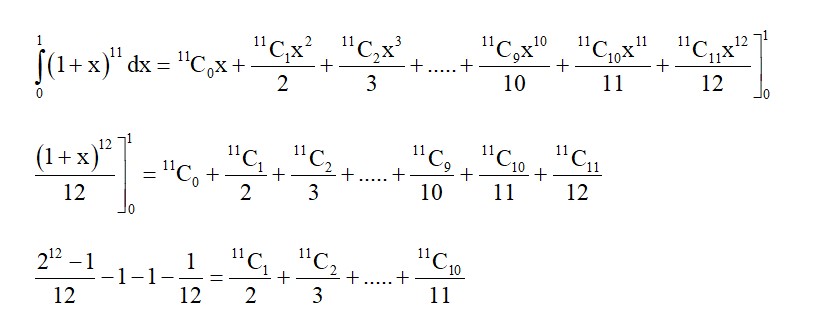If for some positive integer n, the coefficients of three consecutive terms in the binomial expansion of (1 + x)n+5 are in the ratio 5: 10: 14, then the largest coefficient in the expansion is:
If for some positive integer n, the coefficients of three consecutive terms in the binomial expansion of (1 + x)n+5 are in the ratio 5: 10: 14, then the largest coefficient in the expansion is:
Option 1 -
252
Option 2 -
330
Option 3 -
792
Option 4 -
462
-
1 Answer
-
Correct Option - 4
Detailed Solution:N+5C_ {R-1}: N+5C_R: N+5C_ {R+1}
= 5:10:4
2 (N+5C_ {R-1}) = N+5C_R ⇒ 3R = N + 6
7 (N+5C_R) = 5 (N+5C_ {R+1}) ⇒ 12R = 18 + 5N
Solving: N = 6, R = 4
∴ the largest coefficient is N+5C_ {R+1} = 11C_5 = 462
Similar Questions for you

For integral term
6 should divide r
and must be integer
->2 most divide r
->r divisible by 6
->possible values of r Î {0, 1, 2, …824}
->For integer terms
r Î {0, 6, 12, …822} (822 = 0 + (n – 1)6 Þ n = 138)
= 138 terms
The common mistakes can be - using the formula incorrectly, before applying the formula students not simplify the expression, in Binomial Expansion, sometimes they forget to include the fractional and negative exponents, and using incorrect values for a, b, and n.
The Binomial model is known as the Lattice Model or Binomial Option Pricing Model.
There are a total of 36 questions comprising 14 straightforward formula-based sums, 16 challenging problems, and 6 intermediate.
Taking an Exam? Selecting a College?
Get authentic answers from experts, students and alumni that you won't find anywhere else
Sign Up on ShikshaOn Shiksha, get access to
- 65k Colleges
- 1.2k Exams
- 679k Reviews
- 1800k Answers

